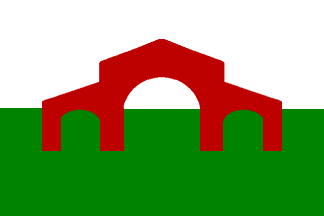 zachary harden
zachary harden
Keywords: csongrad | nagylak | gate | border | nadlac |
Links: FOTW homepage | search | disclaimer and copyright | write us | mirrors

FOTW beschäftigt sich mit der Wissenschaft der Vexillologie (Flaggenkunde).
Alle auf dieser Website dargebotenen Abbildungen dienen ausschließlich der Informationsvermittlung im Sinne der Flaggenkunde.
Wir distanziert uns ausdrücklich von allen hierauf dargestellten Symbolen verfassungsfeindlicher Organisationen.
Last modified: 2023-06-03 by  zachary harden
zachary harden
Keywords: csongrad | nagylak | gate | border | nadlac |
Links: FOTW homepage |
search |
disclaimer and copyright |
write us |
mirrors

image by István Molnár, 9 April 2001
See also:
Other sites:
Nagylak is a new village in Csongrad County (est. 1923),
formerly part and railway station of Nagylak village (now Nadlac
town, Romania) annexed to Romania by the Treaty of Trianon in
1920. The red gate on the flag relates to the important border
crossing.
István Molnár, 9 April 2001
Nagylak is a village in Csongrád county - really closed to
the Romanian border (see map at <www.terkepcentrum.hu>.
Nagylak originally is a part of Nagylak (now Nadlac, RO) town.
After the Treaty of Trianon the Nagylak Rlw.St. became a new
village in 1922.
2001 Population Census: 628 inh. Ethnic affiliation: Hungarian:
79,6%; German: 0,5%; Rumanian: 1,3%; Slovakian: 0,7%; unknown,
did not wish to answer: 20,3% Religion: Roman catholic: 38,2%;
Greek catholic: 1,0%; Calvinist: 9,4%; Lutheran: 9,4%; belonging
to other church/denomination: 0,5%; does not belong to any
church/denomination: 19,8%; unknown, did not wish to answer:
21,8% (see <helynevtar.ksh.hu>).
History of Nagylak/Nadlac/Nad'lak: The first mention of the
castle is from 1192. In 1241 the Mongols occupied the castle and
killed the defenders. The first mention of the settlement is from
1313 as 'NOGLOK'. The first known landlord was Egyed de Monoszló
(Gergely Monoszló?) . The settlement was the seat of the Tenure
of Nagylak (60 villages and 14 farms in the 15th
century). On May 1514 (the pheasant revolution
leadered by György Dózsa) there was a great massacre in
Nagylak. Landlords was killed setllement was burned. The
Hungarian inhabited settlement settled by Serbs in
1464 and King Mathias I. gave the town to the Serbian lord,
Jaksic in 1474. The new castle (brick) was built in 1518 by the
Jaksics. After the battle of Mohács (1526) the settlement became
a part of the Kingdom of John I. After the death of King John I.
the settlement was occupied by the Habsburgs. In 1550 the castle
and the town was occupied by the Turks (by Gazi Kasim leader of
Buda Vilayet). In 1550 it was recaptured and burned by István
Losonczy the Captain of Temesvár. In 1552 it was captured by the
troops of Queen Isabela (widow of King John I.), later it was
captured by the Turks and in november recaptured by the Habsburg
Hungarian army. On June 1553 the Turks occupied the settlement
and it was under Ottoman rule untill 1594, when Prince Sigismund
Báthory - Prince of Transylvania recaptured it. In 1598 Turks
occupied and in 1616 destroyed the fort. The settlement was
liberated in 1699 by the Treaty of Karlowitz. At the time of the
Turkish wars the settlement and its vicinity were devastated. The
settlement was resettled by Romanians and Serbs. In 1739 Serbs
leaved the settlement and in 1803 Slovakians arrived. Nagylak was
the part of the Csanád county of the Kingdom of Hungary until
1919/1920. It was occupied by the Romanian troops in 1919 and
-without the Rlw.St.- it was annexed to Romania by the Treaty of
Trianon in 1920. Border-crossing point opened in 6 April
1968 in Nagylak-Nadlac.
Sources: <www.vendegvaro.hu>,
<hu.wikipedia.org>,
<www.primaria-nadlac.ro>,
<vincze.adatbank.transindex.ro>.
István Molnár, 25 January 2006
cs-nl.jpg)
image from <natloz.znet.hu>,
located by István Molnár, 25 January 2006
Hosted by: Fanshop-Online.de und Handy-Shop.de
Tipp: Apple iPhone 15 im Shop